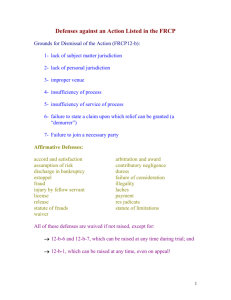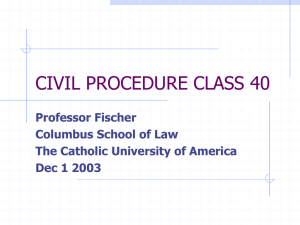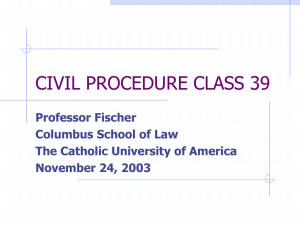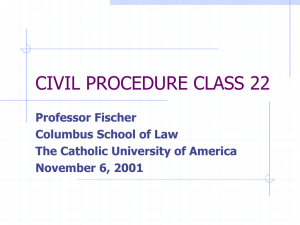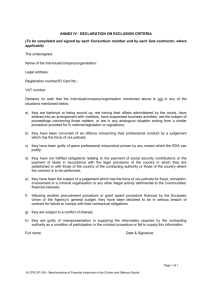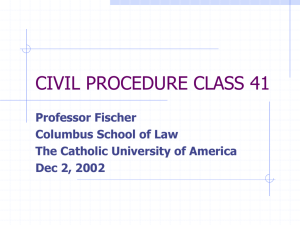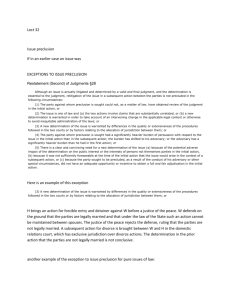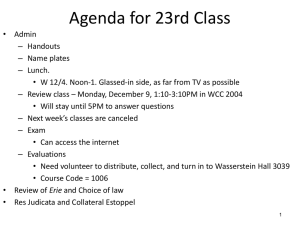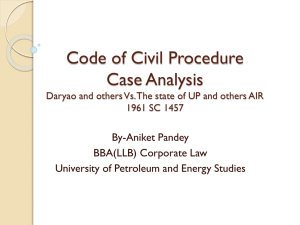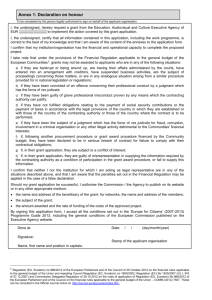civil procedure class 10 - Catholic University of America
advertisement
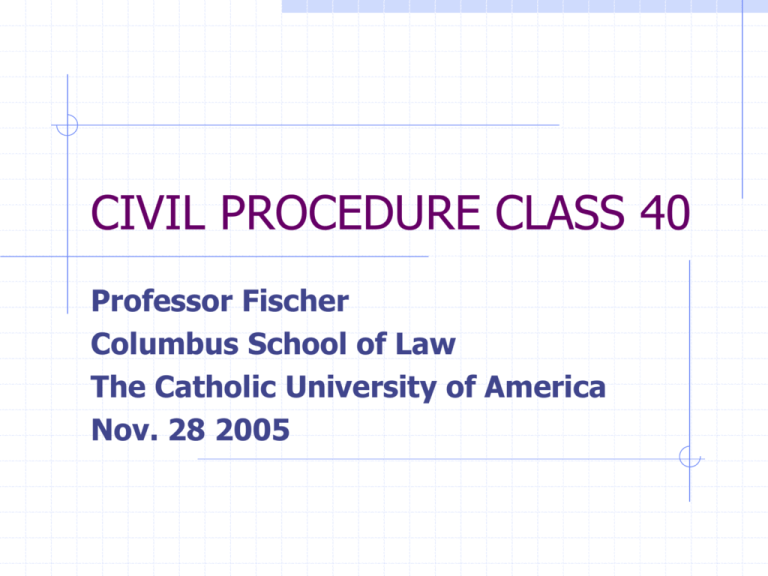
CIVIL PROCEDURE CLASS 40 Professor Fischer Columbus School of Law The Catholic University of America Nov. 28 2005 ELEMENTS OF CLAIM PRECLUSION 1. Prior suit that proceeded to a final valid judgment on the merits 2. Present suit arises out of same claim as the prior suit 3. Same claimant against the same defendant (or litigants in privity with them) CONTRASTING RES JUDICATA WITH JOINDER Why does Glannon describe res judicata as a myrmidon? Contrast the rules for res judicata with the joinder rules VARIETY OF PRECLUSION RULES Note that each state system has its own rules on preclusion Note also that there has been a general trend of increased preclusion WHAT IS THE SAME CLAIM? Federal courts generally employ a “transactional” approach to determining whether the claim in the first suit is the same as the claim in the second suit. Describe this “transactional” approach (See Restatement (2d) of Judgments s. 24 ALI RESTATEMENT (2d) OF JUDGMENTS Most influential modern claim preclusion test §24(1) “…the claim extinguished includes all rights of the plaintiff to remedies against the D with respect to all or any part of the transaction, or series of connected transactions, out of which the action arose.” TRANSACTION/OCCURRENCE TEST BARS…. Not only claims that were brought in the original action but also claims that were available to the plaintiff in the first suit if they arose out of the underlying transaction/occurrence that gave rise to the first suit Note that this is a more narrow approach than the joinder rules (see R. 18) OTHER MINORITY APPROACHES To determining what is the same claim 1. Same evidence test 2. Same right test (also called primary rights theory) CLAIM SPLITTING CLAIM PRECLUSION HYPO Jeremy’s car is damaged in a collision with Marie’s car. Jeremy sues Marie in negligence for damage to the right fender of his car. The claim is dismissed on Marie’s motion for summary judgment. Can Jeremy then sue Marie for damage to the left fender of his car allegedly suffered in the same accident? SAME PARTIES/PARTIES IN PRIVITY What is privity for the purposes of res judicata? Gonzalez v. Banco Central Corp. (1st Cir. 1994) What are the key facts? What is the procedural history? What is the issue on appeal? Did the Gonzalez plaintiffs win their appeal to the First Circuit? CONTRASTING RES JUDICATA WITH JOINDER Why does Glannon describe res judicata as a myrmidon? Contrast the rules for res judicata with the joinder rules VARIETY OF PRECLUSION RULES Note that each state system has its own rules on preclusion Note also that there has been a general trend of increased preclusion ISSUE PRECLUSION What is its function? What is its other name? CONTRAST CLAIM/ISSUE PRECLUSION Res judicata is a BLUDGEON; collateral estoppel is a scalpel What are the elements of issue preclusion? ELEMENTS OF ISSUE PRECLUSION (s. 27 Restatement (Second) of Judgments Same issue Actually litigated Actually decided (final valid judgment ion the merits) Determination is essential to judgment Some state courts require mutuality, i.e. same parties Final Valid Judgment on Merits Same requirement as for claim preclusion Same Issue was Litigated and Determined in Case 1 NECESSARY TO THE JUDGMENT A useful test: ask yourself if the issue had been decided the opposite way, would the same judgment have been entered? If so, the judgment did not depend on the way the issue was actually resolved. Mutuality Parklane Hosiery v. Shore 439 U.S. 322, CB p. 914 What is a proxy statement? Offensive vs. Defensive use of collateral estoppel You should know the case of BlonderTongue, 402 U.S. 313, cited in Parklane at 916. Offensive Collateral Estoppel Justice Stevens in Parklane (CB p. 917): “Offensive use of collateral estoppel does not promote judicial economy in the same manner as defensive use does.” Why not? Offensive Collateral Estoppel Provides incentive for Ps to “wait and see” May be unfair to a defendant According to the majority in Parklane, should the court allow the offensive use of collateral estoppel in the circumstances of that case? Why did the dissent disagree? Due Process Limit on Nonmutual Collateral Estoppel Applies only to litigant who has already lost on the issue, not someone who has never had a chance to litigate the issue. P.E. 36 CB p. 941
